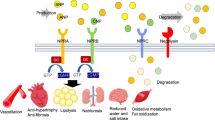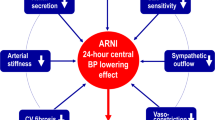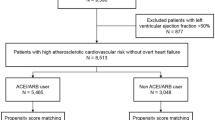Abstract
Stroke is a major cause of death and disability and its incidence increases linearly with age and the level of systolic and diastolic blood pressure. Stroke, besides being a cause of long-term disability for the affected person, also imposes a significant burden on society and healthcare costs. Although good blood pressure control is very critical for stroke prevention, angiotensin receptor blockers (ARBs) may be superior to angiotensin-converting enzyme inhibitors (ACEIs) for the same degree of blood pressure control. This hypothesis has clinical and experimental support. ARBs prevent stroke incidence by blocking the angiotensin II (AII), AT1 receptors preventing brain ischaemia and allowing AII to stimulate the unoccupied AT2 receptors, which improve brain ischaemia. ACEIs, by reducing AII generation, are less effective in preventing stroke. This hypothesis provides evidence that AII plays an important role in the prevention of stroke. Certain ARBs like losartan, and telmisartan, irbesartan and candesartan possess additional properties which may play a role in stroke prevention, which is independent of AII. These include antiplatelet aggregating, hypouricemic, antidiabetic and atrial antifibrillatory effects. However, the most critical factor in stroke prevention is good blood pressure control irrespective of drug used.
This is a preview of subscription content, access via your institution
Access options
Subscribe to this journal
Receive 12 digital issues and online access to articles
$119.00 per year
only $9.92 per issue
Buy this article
- Purchase on Springer Link
- Instant access to full article PDF
Prices may be subject to local taxes which are calculated during checkout


Similar content being viewed by others
References
Chobanian AV et al. Seventh Report of the Joint National Committee on prevention, detection, evaluation, and treatment of high blood pressure (JNC-7). Hypertension 2003; 42: 1206–1252.
Lewington S et al. Age-specific relevance of usual blood pressure to vascular mortality: a meta-analysis of individual data from one million adults in 61 prospective studies. Prospective Studies Collaboration. Lancet 2002; 360: 1903–1913.
Murray CJL, Lopez AD . Mortality by cause for eight regions of the world: global burden of disease study. Lancet 1997; 349: 1269–1276.
Murray CJL, Lopez AD . Global mortality, disability and the contribution of risk factors: global burden of disease study. Lancet 1997; 349: 1436–1442.
Goldstein LB et al. Primary prevention of ischemic stroke. A statement for healthcare professionals from the Stroke Council of the American Heart Association. Circulation 2001; 103: 163–182.
Broderick J et al. The greater Cincinnati/northern Kentucky Stroke Study: preliminary first-ever and total incidence rates of stroke among blacks. Stroke 1998; 29: 415–421.
American Heart Association. Heart Disease and Stroke Statistics—2005 Update. American Heart Association: Dallas, TX. Available at: http://www.americanheart.org/(Accessed January 2005).
Dahlof B et al. Population impact of losartan use on stroke in the European Union (EU): projections from the Losartan Intervention For Endpoint reduction in hypertension (LIFE) study. J Hum Hypertens 2004; 18: 367–373.
Kjeldsen SE, Julius S, Hedner T, Hansson L . Stroke is more common than myocardial infarction in hypertension: analysis based on 11 major randomized intervention trials. Blood Press 2001; 10: 190–192.
Fournier A, Messerli FH, Achard JM . Cerebroprotection mediated by angiotensin II. A hypothesis supported by recent randomized clinical trials. J Am Coll Cardiol 2004; 43: 1343–1347.
Chrysant SG . Stroke prevention with losartan in the context of other antihypertensive drugs. Drugs Today 2004; 40: 791–801.
DePaolis P et al. Modulation of the AT2 subtype receptor gene activation and expression by the AT1 receptor in endothelial cells. J Hypertens 1999; 17: 1873–1877.
Brown MJ, Brown J . Does angiotensin II protect against strokes? Lancet 1986; 2: 427–429.
The Medical Research Council Working Party. The MRC trial of treatment of mild hypertension: principal results. BMJ 1985; 291: 97–104.
The MRC Working Party. The Medical Research Council trial of treatment of hypertension in older adults: principal results. BMJ 1992; 304: 405–412.
The SHEP Cooperative Research Group. Prevention of stroke by antihypertensive drug treatment in older persons with isolated systolic hypertension: final results of the Systolic Hypertension in the Elderly Program (SHEP). JAMA 1991; 265: 3255–3264.
The Antihypertensive and Lipid Lowering Treatment to Prevent Heart Attack Trial. The ALLHAT officers and coordinators for the ALLHAT Collaborative Research Group. JAMA 2002; 288: 2981–2997.
Staessen JA, Wang JG, Thijs L . Calcium channel blockade and cardiovascular prognosis: recent evidence from clinical outcome trials. AM J Hypertens 2002; 15: 85S–93S.
Chrysant GS, Chrysant SG . Has the role of calcium channel blockers in treating hypertension finally been defined? Curr Hypertens Rep 2003; 5: 295–300.
The PROGRESS Colaborative Group. Randomized trial of a perindopril-based blood-pressure-lowering regimen among 6105 individuals with previous stroke or transient ischemic attack. Lancet 2001; 358: 1033–1041.
PATS Collaborating group. Post-stroke Antihypertensive Treatment Study. Chin Med J 1995; 108: 710–717.
Hansson L et al. Effect of angiotensin-converting-enzyme inhibition compared with conventional therapy on cardiovascular morbidity and mortality in hypertension: the Captopril Prevention Project (CAPP) randomized trial. Lancet 1999; 353: 611–616.
Wing LM et al. A comparison of outcomes with angiotensin-converting-enzyme inhibitors and diuretics for hypertension in the elderly. the second Australian National Blood Pressure Study (ANBP2). N Engl J Med 2003; 348: 583–592.
Marre M et al. Effects of low dose ramipril on cardiovascular and renal outcomes in patients with type 2 diabetes and raised excretion of urinary albumin: randomized, double-blind, placebo control trial (the DIABHYCAR study). BMJ 2004; 328: 495–501.
Blood Pressure lowering Treatment Trialists Collaboration. Effects of different blood-pressure-lowering regimens on major cardiovascular events: results of prospectively-designed overviews of randomized trials. Lancet 2003; 362: 1527–1535.
Yusuf S et al. The Heart Outcomes Prevention Evaluation (HOPE) study investigators. Effects of an angiotensin-converting-enzyme inhibitor, ramipril, on cardiovascular events on high-risk patients. N Engl J Med 2000; 342: 145–153.
Moore T et al. Ischemic stroke: impact of a recent myocardial infarction. Stroke 1999; 30: 997–1001.
Dahlof B et al. Cardiovascular morbidity and mortality in the Losartan Intervention For Endpoint (LIFE) reduction in hypertension: a randomized trial against atenolol. Lancet 2002; 359: 995–1003.
Kjeldsen SE et al. Effects of losartan on cardiovascular morbidity and mortality in patients with isolated systolic hypertension and left ventricular hypertrophy: a Losartan Intervention For Endpoint reduction (LIFE) sub-study. JAMA 2002; 288: 1491–1498.
Lithell H et al. The Study on Cognition and Prognosis in the Elderly (SCOPE): principal results of a randomized double-blind intervention trial. J Hypertens 2003; 21: 875–886.
Papademitriou V et al. Stroke prevention with the angiotensin II type-1 receptor blocker candesartan in elderly patients with isolated systolic hypertension: The Study on Cognition and Prognosis is in the Elderly (SCOPE). J Am Coll Cardiol 2004; 44: 1175–1180.
Schrader J, et al, on behalf of the ACCESS study group. The ACCESS Study: evaluation of acute candesartan cilexetil therapy in stroke survivors. Stroke 2003; 34: 1699–1703.
Nazir FS et al. The effects of losartan on global and focal cerebral perfusion and on renal function in hypertensives with mild early ischemic stroke. J Hypertens 2004; 22: 989–995.
Julius S et al. Outcomes in hypertensive patients at high risk treated with regimens based on valsartan or amlodipine: the VALUE randomized trial. Lancet 2004; 363: 2022–2031.
Schrader J et al. Morbidity and Mortality after Stroke, Eprosartan compared with Nitrendipine for Secondary Prevention. Principal results of a prospective randomized controlled study (MOSES). Stroke 2005; 36: 1218–1226.
Fernandez LA et al. Fenin-angiotensin and development of collateral circulation after renal ischemia. Am J Physiol 1982; 243: H869–H875.
Fernandez LA, Spencer DD, Kaczmar Jr J . Angiotensin II decreases mortality rate in gerbils with unilateral carotid ligation. Stroke 1986; 17: 82–85.
Fernandez LA et al. Angiotensin AT2 receptor stimulation increases survival in gerbils with abrupt unilateral carotid ligation. J Cardiovsc Pharmacol 1994; 24: 937–940.
Dai WJ et al. Blockade of central angiotensin AT1 receptors improves neurologic outcomes and reduces expression of AP-1 transcription factors after focal brain ischemia in rats. Stroke 1999; 30: 2391–2399.
Dalmay F et al. Non-AT1-receptor-mediated protective effect of angiotensin against acute ischemic stroke in the gerbil. JAAS 2001; 2: 103–106.
Stier CT et al. Stroke prevention by losartan in stroke-prone spontaneously hypertensive rats. J Hypertens 1993; 11 (Suppl 3): S37–S42.
Vacher E, Richer C, Giudicelli JF . Effects of losartan on cerebral arteries in stroke-prone spontaneously hypertensive rats. J Hypertens 1996; 14: 1342–1348.
Yusuf S et al. Effects of candesartan in patients with chronic heart failure and preserved left ventricular ejection fraction: the CHARM-Preserved Trial. Lancet 2003; 362: 777–781.
Grundy SM et al. Diabetes and cardiovascular disease: a statement for healthcare professionals from the American Heart Association. Circulation 1999; 100: 1134–1146.
Ogihara T et al. Angiotensin II-induced insulin resistance is associated with enhanced insulin signaling. Hypertension 2002; 40: 872–879.
Paolisso G et al. Losartan mediated improvement in insulin action is mainly due to an increase in non-oxidative glucose metabolism and blood in insulin resistant hypertensive patients. J Hum Hypertens 1997; 11: 307–312.
Shiuchi T et al. Angiotensin II type-1 receptor blocker valsartan enhances insulin sensitivity in skeletal muscles of diabetic mice. Hypertension 2004; 43: 1003–1010.
Janke J et al. Mature adipocytes inhibit in vitro differentiation of human preadipocytes via angiotensin type 1 receptors. Diabetes 2002; 51: 1699–1707.
Kurtz TW, Pravenec M . Antidiabetic mechanisms of angiotensin-converting enzyme inhibitors and angiotensin II receptor antagonists: beyond the renin–angiotensin system. J Hypertens 2004; 22: 2253–2261.
Benson SG et al. Identification of telmisartan as a unique angiotensin II receptor antagonist with selective PPARj-modulating activity. Hypertension 2004; 43: 993–1002.
Guerra-Custa JI et al. Effect of losartan on human platelet activation. J Hypertens 1999; 17: 447–452.
Jimenez AM et al. Inhibition of platelet activation in stroke-prone spontaneously hypertensive rats: comparison of losartan, candesartan and valsartan. J Cardiovasc Pharmacol 2001; 37: 406–412.
Noguchi T et al. Enhanced thrombogenicity and altered hemodynamics in the cerebral microvasculature of stroke-prone spontaneously hypertensive rats. Hemostasis 1997; 27: 237–245.
Ogata J et al. Vascular changes underlying cerebral lesions in stroke-prone spontaneously hypertensive rats. A serial section study. Acta Neuropathol 1981; 54: 183–188.
Sundström J et al. Relations of serum uric acid to longitudinal blood pressure tracking and hypertension incidence. Hypertension 2005; 45: 28–33.
Alper AB et al. Childhood uric acid predicts blood pressure. The Bogalusa Heart Study. Hypertension 2005; 45: 34–38.
Lehto S et al. Serum uric acid is a strong predictor of stroke in patients with non-insulin dependent diabetes mellitus. Stroke 1998; 29: 635–639.
Verdecchia P et al. Relation between serum uric acid and risk of cardiovascular disease in essential hypertension. The PIUMA Study. Hypertension 2000; 36: 1072–1078.
Fang J, Alderman MH . Serum uric acid and cardiovascular mortality, the NHANES1 epidemiologic follow-up study, 1971–1992. National Health and Nutrition Examination Survey. JAMA 2000; 283: 2404–2410.
Johnson RJ et al. Is there a pathogenetic role for uric acid in hypertension and cardiovascular and renal disease? Hypertension 2003; 41: 1183–1190.
Chapman PT et al. Endothelial activation in monosodium urate monohydrate crystal inflammation: in vitro and in vivo studies on the roles of tumor necrosis factor alpha and interlukin-1. Arthritis Rheum 1997; 40: 955–965.
Jacques BC, Ginsberg MI . The role of cell surface proteins in platelet stimulation by monosodium urate crystals. Arthritis Rheum 1982; 25: 508–521.
Butler R et al. Allopurinol normalizes endothelial dysfunction in type 2 diabetics with hypertension. Hypertension 2000; 35: 746–751.
Doehner W et al. Effects of xanthine oxidase inhibition with allopurinol on endothelial function and peripheral blood flow in hyperuricemic patients with chronic heart failure Results from 2 placebo-controlled studies. Circulation 2002; 105: 2619–2624.
Hoieggen A et al. Serum uric acid and hemorheology in borderline hypertensives, and in subjects with established hypertension and left ventricular hypertrophy. Blood Press 2003; 12: 104–110.
Yusuf S . From the HOPE to the ONTARGET and TRANSCEND studies. Challenges in improving prognosis. Am J Cardiol 2002; 89: 18A–25A.
Alderman M, Aiyer KJ . Uric acid: role in cardiovascular disease and effects of losartan. Curr Med Res Opin 2004; 20: 369–379.
Madrid AH et al. Use of irbesartan to maintain sinus rhythm in patients with long-lasting persistent atrial fibrillation. A prospective and randomized study. Circulation 2002; 106: 331–336.
Wachtell K et al. Angiotensin II receptor blockade reduces new onset atrial fibrillation and subsequent stroke compared to atenolol. J Am Coll Cardiol 2005; 45: 712–719.
Kumagai K et al. Effects of angiotensin II type 1 receptor antagonist on electrical and structural remodeling in atrial fibrillation. J Am Coll Cardiol 2003; 41: 2197–2204.
Hoieggen A et al. The impact of serum uric acid on cardiovascular outcomes in the LIFE study. Kidney Int 2004; 65: 1041–1049.
Author information
Authors and Affiliations
Corresponding author
Rights and permissions
About this article
Cite this article
Chrysant, S. Possible pathophysiologic mechanisms supporting the superior stroke protection of angiotensin receptor blockers compared to angiotensin-converting enzyme inhibitors: clinical and experimental evidence. J Hum Hypertens 19, 923–931 (2005). https://doi.org/10.1038/sj.jhh.1001916
Received:
Revised:
Accepted:
Published:
Issue Date:
DOI: https://doi.org/10.1038/sj.jhh.1001916
Keywords
This article is cited by
-
The Role of Angiotensin II Receptors in Stroke Protection
Current Hypertension Reports (2012)
-
The Effects of Poststroke Captopril and Losartan Treatment on Cerebral Blood Flow Autoregulation in SHRsp with Hemorrhagic Stroke
Journal of Cerebral Blood Flow & Metabolism (2011)
-
Treatment of hypertension with olmesartan medoxomil, alone and in combination with a diuretic: an update
Journal of Human Hypertension (2007)
-
The 2007 revised ESC/ESH Guidelines in the management of hypertension: clarifying individual patient care
Journal of Human Hypertension (2007)



